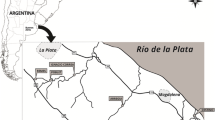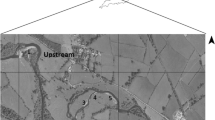Abstract
Ranunculus spp. are the dominant plants of lowland chalk stream habitats in England. The spatial variability of sediment characteristics (silt–clay, organic matter, total phosphorus and total nitrogen content) within stands of Ranunculus spp. was investigated in 12 rivers in lowland England. Variability was found to be high and there were no discernible differences between samples taken from within Ranunculus and a limited number of samples from bare substrate. For two of these rivers, comparisons were also made between reaches upstream and downstream of waste water treatment works outfalls in terms of the characteristics of the sediments within Ranunculus stands. In one river a clear increase in sediment nutrient, fine and organic material content was observed downstream but in the other there was no consistent difference. Temporal variability was considered for two rivers in the Frome catchment, Dorset, by analysing the monthly variability in sediment organic matter and silt–clay content beneath Ranunculus stands over an annual cycle of growth and die-back. Whilst a clear pattern of fine and organic material retention consistent with seasonal plant growth patterns was evident at one site, the three sites displayed different temporal patterns. This inconsistency is believed to reflect differences in sediment supply at the three sites.



Similar content being viewed by others
References
Clarke, S. J. (2000). Sediment–macrophyte relationships in lowland English rivers: Using macrophytes for biological assessment. PhD Thesis. Department of Geography, Queen Mary, University of London. 354 pp.
Clarke, S. J., & Wharton, G. (2001). Sediment nutrient characteristics and aquatic macrophytes in lowland English rivers. Science of the Total Environment, 266, 103–112.
Cotton, J. A., Wharton, G., Bass, J. A. B., Heppell, C. M., & Wotton, R. S. (2006). The effects of seasonal changes to in-stream vegetation cover on patterns of flow and accumulation of sediment. Geomorphology, 77(3–4), 320–334.
Dawson, F. H. (1976). The annual production of the aquatic macrophyte Ranunculus penicillatus var. calcareus (R. W. Butcher) C. D. K. Cook. Aquatic Botany, 2, 51–73.
Demars, B. O. L. (2002). Aquatic vascular plants in nitrate-rich calcareous lowland streams: Do they respond to phosphorus enrichment and control? PhD Thesis. Department of Biology, University of Leicester. 214 pp.
Environment Agency (2004). The state of England’s chalk rivers. Bristol: Environment Agency. 78 pp.
European Commission (2000). Directive 2000/60/EC of the European Parliament and of the Council of 23 October 2000 establishing a framework for Community action in the field of water policy. Official Journal of the European Communities, L327, 1–72.
Hearne, J. W., & Armitage, P. D. (1993). Implications of the annual macrophyte growth cycle on habitat in rivers. Regulated Rivers, 8, 313–322.
Institute of Hydrology (1999). National River Flow Archive. Wallingford, UK: Institute of Hydrology.
Mainstone, C. P., & Parr, W. (2002). Phosphorus in rivers – ecology and management. Science of the Total Environment, 282–283, 25–47.
Preston, C. D., & Croft, J. M. (1997). Aquatic Plants in Britain and Ireland. Colchester: Harley Books. 365 pp.
Sand-Jensen, K. (1997). Macrophytes as biological engineers in the ecology of Danish streams. In K. Sand-Jensen & O. Pedersen (Eds.), Freshwater Biology – Priorities and Development in Danish Research (pp. 74–101). Copenhagen: G. E. C. Gad.
Schneider, S., & Melzer, A. (2004). Sediment and water nutrient characteristics in patches of submerged macrophytes in running waters. Hydrobiologia, 527, 195–207.
Svendsen, L. M., & Kronvang, B. (1993). Retention of nitrogen and phosphorus in a Danish lowland river system: Implications for the export from the watershed. Hydrobiologia, 251, 123–135.
Wharton, G., Cotton, J. A., Wotton, R. S., Bass, J. A. B., Heppell, C. M., Trimmer, M., et al. (2006). Macrophytes and suspension-feeding invertebrates modify flow and fine sediments in the Frome and Piddle Catchments, Dorset (UK). Journal of Hydrology, 330(1–2), 171–184.
Wheater, H. S., & Peach, D. (2004). Developing interdisciplinary science for integrated catchment management: The UK Lowland Catchment Research (LOCAR) Programme. International Journal of Water Resources Development, 20(3), 369–385.
Acknowledgements
The authors gratefully acknowledge the Environment Agency and Queen Mary, University of London for provision of a studentship to SJC; the award of a NERC LOCAR Grant (NER/T/S/2001/00932); and the support of the Frome/Piddle Catchment Service Team and the NERC LOCAR Data Centre.
Author information
Authors and Affiliations
Corresponding author
Rights and permissions
About this article
Cite this article
Clarke, S.J., Wharton, G. & Cotton, J.A. Spatial and Temporal Variations in the Sediment Habitat of Ranunculus spp. in Lowland Chalk Streams – Implications for Ecological Status?. Water Air Soil Pollut: Focus 6, 393–401 (2006). https://doi.org/10.1007/s11267-006-9051-4
Published:
Issue Date:
DOI: https://doi.org/10.1007/s11267-006-9051-4




